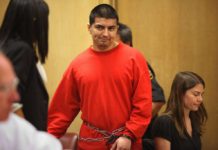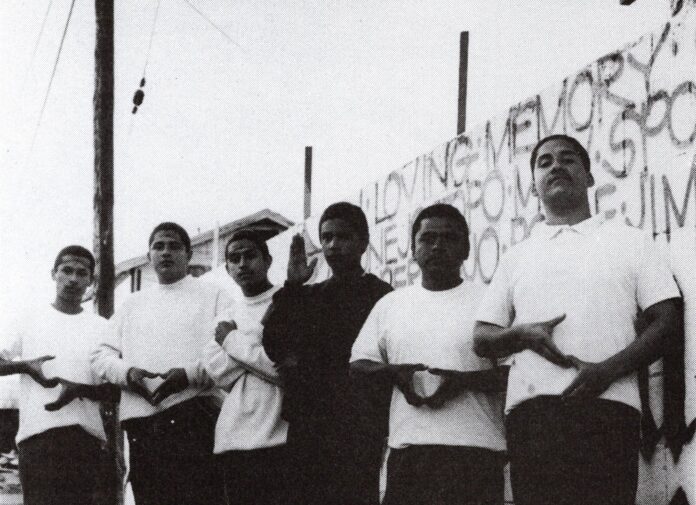
As gang violence in L.A. County continues to claim hundreds of lives, the police have moved to a war footing. The result, critics charge, are incidents like the Rodney King beating and the formation of a pseudo-police state. The cops on the beat don’t see a choice.
[First published more than three decades ago by Southern California Magazine in December 1991, this story was researched and written over a period of weeks spent with officers of the Los Angeles County Sheriff’s Department’s elite anti-gang Operation Safe Streets (OSS) bureau and community outreach professionals as well as the gang members prowling the streets. It was nominated in 1992 for Best Feature News Story by the Western Publishing Association’s ‘Maggie Awards.’]
By Mark Cromer
An unmarked sheriff’s patrol car is cruising the narrow residential streets of South Central Los Angeles. It’s Saturday and the sun is setting. The gang bangers’ day is just starting. As the streets begin to come alive with gangsters and residents in general, including dozens of children that can be seen playing in streets and front yards, the two cops inside the car ease back into their seats, absorbing the view from their mobile island of authority.
For deputies Ralph Garay and Mark Holbrook, two members of the Lennox Sheriff’s Station Operation Safe Streets detail, it’s yet another shift on the southside, another day at the office. Another excursion into what could clearly be seen as enemy-occupied territory by any military planner.
Like another conflict in the not-so-distant past, it’s getting harder to tell the civilians from the combatants. Judging from the rising death toll of bystanders, as well as complaints of police harassment, one wonders if either side cares anymore.
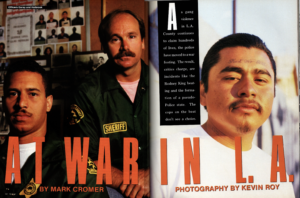
The OSS was developed specifically to do battle with gangs, and if one spends any amount of time at all in the unit’s cramped Lennox office, it is clear they have seen plenty of action. A hunter’s trophy den comes to mind while gazing at the walls.
Just as WW II vets brought home Samurai Swords and Rising Sun Flags, and Vietnam Vets brought home sandals and ears, the cops in South Central L.A. 1991 have this firebase adorned with battle flags (literally) seized from rival gangs, as well as shirts, hats, scarves, jackets and a hodgepodge of posters and other kick-knacks acquired from various fronts of the war.
The shirts and jackets are covered in gangster-speak and set insignias, mostly boasting morbid slogans of who is the meanest, strongest, and biggest, or all three.
“CK” for “Crip Killers” and “BK” for “Blood Killers,” Holbrook pointed to one shirt that pretty much summed it all up: “Hoover, Anybody Killers.” The gang is the Eleven Deuce (112th Street) Hoovers, a notoriously violent Crip set that will, as they happily advertise, kill anybody.
If the display on the walls isn’t enough to clue one in on what these officers face on a nightly basis, the photos they have will.
Striking poses and throwing their signs from jail cells to caskets, where bodies are seen dressed down in gang regalia (with wounds so brutal not even the mortician’s reconstructive wax could hide them), Latino and black gangsters are captured in a glossy world that appears as strange as it really is.
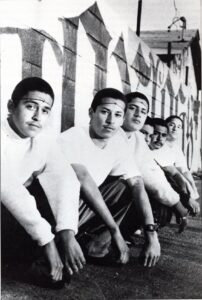
Holbrook explains the photos come from everywhere, including some from gang bangers who have made contributions to the unit’s family album.
Tension in the neighborhoods is very high; one can see it in people’s faces as every black and white cruiser rolls by. The looks are sometimes cold, sharp and hard, sometimes empty, and sometimes traced with just a slight smile.
There is also the occasional wave or thumbs-up from homeowners and children, generally peering out to the street from their porches.
The gang bangers, they smile and wave more often than not, but it’s a sign of affection for these to [sic] deputies that runs no deeper than the gesture itself.
Holbrook notes that a gangster’s looks and body language are very fluid and constantly changing caricatures, often underscoring the opposite of what is or could be going down at the time.
In short, he said, a gangster might talk cooperatively to the deputies with a smile on his face, while planning a drive-by shooting designed to take out a rival gangster, or maybe even a deputy.
Throughout the night, as Holbrook and Garay stop dozens of known gangsters for impromptu and light-hearted rap sessions, not once did they let a gangster step behind their backs.
As a gangster noted, “They know what’s up.”
They do indeed.
Earlier in the evening Holbrook screened a video that highlighted what could be a street gangster’s greatest love: his gun. There are more of them on the streets of Los Angeles now than ever before, and as Holbrook and Garay donned their flak jackets, the screen provided a quick glimpse at just how far it’s gone.
Flickering on the television, a group of Santana block Crips congregates inside a home in South central L.A. A flamboyant but literate Crip named Kenneth Johnson, aka Turtle, shows off their arsenal for the camera crew. The Crip’s banter is light, like kids on Christmas Day, joking as they show off their new presents.
“Two barrels! Look at the barrels!” Johnson notes while toting a double barrel shotgun, “This is a madman’s gun! Double barrel. A madman’s gun… a man who go kill with this is really mad! It will kill.”
Next come the carbines.
“This is an M-1 carbine, 32 rounds. I can go tap Lewis Park with this. I can kill 32 people if I hit ‘em all. Yes indeed. And I own two of these.”
Johnson’s favorite was saved for last.
“A .38 revolver. It really hurts. I had six of ‘em in me, it hurts real bad. That’s why right now I issue it out. Instead of receiving, I ships ‘em.”
Holbrook explains the piece was filmed in 1984, before Uzis and the big AK-47 became popular weapons of choice on the street.
He adds that Johnson did indeed do a little “receiving” not too long after appearing on the tape. He was shot 27 times and killed during a dope deal with a rival gang.
If Turtle’s fate isn’t an indication of what Holbrook and Garay and their peers have to deal with on a nightly basis, the 43-year-old Crip whose philosophy of “I’m Crip or die” is.
The words, like the man who spoke them, are cold and harsh, providing a brief but unrelenting look into the mind of a Los Angeles gang banger.
The simplicity of it all was beautiful in a slightly perverse way, reminding one of the old nationalistic slogan coined during the British Empire: “Once an Englishman, always an Englishman.”
To this gangster, his set is his nation and the street blocks are its borders. He has been a Crip, he is a Crip, and he will be a Crip until he dies.
And if he leaves this planet in a fusillade of bullets, chances are he will be buried with full Crip honors, which includes being laid to rest dressed in gang colors while his “homeboys” look on in a somber, paramilitary fashion.
The fact that by the time this Crip dies he may have taken a rival Blood or two down with him, as well as some kids who “got in the way,” means only more glory for his gang’s set.
In their words: You live hard, you die hard and it’s all about being a gangster.
It sounds insane and it is, but reality in South Central Los Angeles in 1991 has taken on the aura of a dark comic book, a war zone where the good guys are in one gang and the bad guys are in another and a terrified populace is simply reduced to watching these urban militias slug it out.
That’s what’s up on the street. Hardcore violence. Scarface for real.
Holbrook said only the night before a deputy in Marina Del Rey got the crap kicked out of him by five guys who appeared to be gang bangers. The deputy stopped them on a bike path and by the time a back-up could arrive he was at the bottom of a hill, unconscious and lucky to be alive.
Though the detail was buzzing in the aftermath of the beating, there seemed more shock than surprise. Yet it’s something that is happening more and more, Holbrook said.
Though the images that the name Rodney King now evoke seem to be a catalyst for resentment against the LAPD, Holbrook notes gangsters have been more at odds with the city’s cops for quite some time.
While not shotgunning the department’s policy as some community and social workers have, Holbrook did note the LAPD’s penchant for zealous enforcement. As Chief Gates once boasted, they still take ‘em in for anything and everything. The sheriff’s department, on the other hand, seems to essentially follow a policy of: no guns, no dope, no bust.
Politically popular? Perhaps not, but extremely pragmatic in these days of overcrowding, early releases and the fact that an arrest can pull an officer off the street for hours at a time because of paperwork.
LAPD’s enforcement of “everything” might play well for the television crews hoping to cash in on a slick tele-opportunity, the kind with a stage name like Operation Hammer, but it seems only to amuse the gangsters (who remain active in their sets behind bars), and infuriate residents who feel harassed.
Again and again throughout the night, gangsters both in and out of earshot of the deputies recounted tales of what they said were daily Rodney King incidents sans the camcorder. The irony, of course, is listening to a guy called Little Killer, who would happily empty a clip into a rival gang member (or a child bystander) to uphold respect for his block, bemoan police harassment.
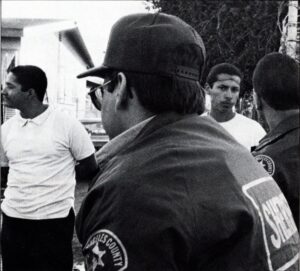
Though hardly endorsing what happened to King, maintaining an aura of power seems to be a primary concern of the deputies on the street. Garay seemed to semi-relish the intimidation factor.
“If we can maintain that fear, that would be great.”
How did that saying go in Nam? Jesus saves, Cav kills….
Despite the high tension, any sheer open animosity seems to have been put on hold for the night, and during most of the stops the banter back and forth between the deputies and the gangsters more closely resembles old friends playing catch-up than any serious officer-to-suspect street interrogation.
Perhaps it is another matter of pragmatics, with the cops understanding that it they really want to get the dirt on who’s doing what, they’d better be willing to play the game.
Holbrook and Garay slip into gang slang almost as soon as they step from their car. The gangsters smile and give it right back.
Late into the evening Holbrook wheels the car quickly down an alley into South Los territory, a Hispanic gang that has recently been at war with the Eleven Deuce Hoovers, a black gang. As the car approaches the circle of a half dozen young men, none of them scatter, though they recognize the car easily enough to have fled in time.
Holbrook notes that if they don’t run, it generally means they are not carrying guns or dope, though neither is probably far away.
The wall alongside the alley is covered in large black letters, proclaiming the set’s territory. One of their members, “Cartoon,” has been killed. A tribute to him is also painted on the wall.
The bangers mill about, almost bashfully at first, not wanting to say much to either the deputies or the reporters. But as Holbrook and Garay work them, carefully mixing the lingo with inside jokes and jibes, they slowly come around.
One of the older members takes off his hat to the delight of his fellow gangsters. He is sporting a tattoo on his forehead. It reads like a slogan from the hard currency of the streets: “Trust No Bitch.”
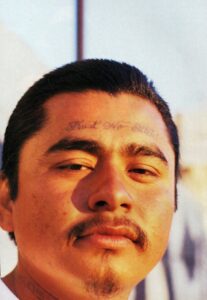
Holbrook wants to know why South Los is gunning it out with Eleven Deuce.
“Because they love me so much,” one of them cracks back.
As the conversation progresses, a subtle fact becomes apparent, no one seems exactly sure why indeed it is on with Eleven Deuce. Perhaps they do and aren’t saying, or perhaps, as Holbrook later notes, whatever original incident that started the recent cycle of violence has long since passed but the violence continues, an everyday application of a distant memory.
The South Los boys finally agree to stand in front of their wall, their landmark, their slice of the American pie, and throw up their sign that they take as seriously as a Marine vet does Old Glory. Their looks get hard again. Respect. If you laugh at them, you’d better be riding with the cops.
Nearby, a huge mural of Jesus Christ is spread across the side of a wall. Surrounding it are abandoned homes that have been gutted and grafittied [sic] to the point of no return. The Jesus mural remains unmolested, untouched, perhaps a last chance glimpse of Catholic hope in the barrio. Children play in front of it, their dirty faces beaming. Holbrook watches them, then shakes his head.
“And what chance do they have?”
Driving away, the mood picks up a little as the conversation turns to “ghetto elk,” or what the cops call dogs roaming the street.
With this year poised to be yet another record-breaking monument to homicide in Los Angeles County, officials seem to be divided on what to do. Some authorities are calling for more cops and as many prisons as Pete Wilson can build, a view that often finds a sympathetic home in front-line troops like Holbrook and Garay.
Social workers and street activists, however, are criticizing such “tough guy” talk, calling it short-sighted, politically sloganistic and largely ineffective. More cops on the street, they argue, fails to deal with what they believe are the deeper, more complex issues that surround the gang problem.
The one element in the debate over what should be done about the 50,000 known gang bangers that now prowl Los Angeles County, which both cops and county workers seem to agree on, is decidedly pessimistic. The diagnosis is terminal. The Lebanonization of L.A. is near complete.
While both the cops and social workers agree that perhaps there is still hope of neutering the gangs, limiting their scope and deadly gun fire, any thought of wiping them out of the county now is utter nonsense.
Despite this, the two sides are bitterly divided on not only who is responsible for this nightly chaos, but what the best course of action is to control it.
As Paul Jones sits at his desk brooding over the question poised to him, he seems to simmer with anger and frustration. It’s a quiet rage just under the surface of his skin. A rage that occasionally surfaces in the pointed answers he gives while diagnosing the nightly death and destruction in the streets of South Central Los Angeles.
Jones is a supervisor in the county’s Youth Gang Services Project, a position he has held for almost a year. Prior to moving into that slot at YGSP, Jones has worked in community programs for the past 25 years, watching the urban specter of gangs grow worse with every passing year while politicians, from every point on the political spectrum, have promised to “get tough” and eliminate the problem.
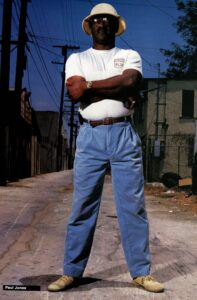
It’s now over 25 years since Watts erupted in the display of bloodshed that forever marked not only the city, but the nation. Twenty-five years since that long hot summer brought the National Guard to L.A.’s street but, as Jones notes, little has changed and a lot has gotten worse.
While the contributing factors to gangs, those of poverty, unemployment, drugs and lack of education continue almost unabated in South Central L.A., Jones heatedly criticizes the fact that the emphasis is still on law enforcement as a solution. Putting more cops on the street now, he said, is simply a tragic case of too little, too late. Though he ponders his words carefully, he doesn’t mince many.
“I don’t think that those particular “law enforcement” efforts have been as effective as what we do on a daily basis. One of the sad problems that continues to exist, one of the things that consistently happens with the politicians, is they wait until it’s too late to take action.
“The gang problem that we have in Los Angeles would not be in the proportion that we have now, had the politicians taken action when they first started seeing it happen.”
Though it might appear a partisan position, Jones argues that to the contrary, he’s not pinning the blame on any particular political party or person. In fact, he said, the blame rests on a lot of shoulders, including John Q. Public’s.
“I think that we are talking about anybody that’s in a position of power and decision-making that can impact and influence others to make changes. The blame does rest broadly, on the community and, majorily [sic], in the political arena. We are looking at a situation where, I believe, we never really tried to address our social ills.
“It’s like a cancerous sore and here we are putting a BandAid on a cancerous sore. Meanwhile, the sore is consistently growing.”
The fact that the political machine in the county has long been dominated by whites is not lost on Jones and it’s a fact, he said, that has cultivated a militaristic character to law enforcement policies and procedures.
The black gang problem was not addressed in its formative years, in the mid- to late-1970s and early 1980s, Jones asserts, largely because white politicians saw the problem as a black one, assuming at the time that it was an issue that didn’t impact their white neighborhoods.
That attitude and the course of inaction that followed it, Jones said, has been and still does flow from a deep wellspring of racism.
“We, society, refuse to address the issue of racism. We know it exists, we know it has existed for God knows how long, yet we continue to not address the differences in people and seriously educate people relative to people. We just don’t do it.”
As he reflects on it now, Jones notes that as far as he can tell, county, state and even federal officials have not learned from past mistakes.
“They could have expanded programs such as this one, in the late 1970s, and expanded it to the point and degree to offset the growth [of gangs]. Now what we are seeing, what the politicians are doing is they are utilizing monies which could go to programs like this, for the building of more prisons.”
It is a doomed cycle, he said, one that merely self-perpetuates and magnifies the tragedy.
“Any fool knows that if you are talking about building more prisons, you are talking about housing more people and if you’re talking about housing more people in a prison setting you are just looking at more people who are someday going to get out very hardened and with a view to get back at society.
“No, no, prison does not rehabilitate. How can it? The very setting itself does not allow you to rehabilitate.”
His words for the people who put gangsters behind bars, L.A.’s finest, are not much kinder. He is sympathetic to the fact that cops in the county are caught in a competition with other county agencies, like YGSP, for cash in a budget-axing season, as well as having to face these heavily armed gangs who put out human lives with as much ease as one might put out a cigarette.
He is not sympathetic, however, to the “Take No Prisoners” attitude the LAPD and county sheriff’s department has been fostering for years now. It’s an attitude that Jones said has now spilled over into even targeting county social workers as enemies of the police.
“What everybody has to understand is that everyone of these different entities [police, county and community groups] has a certain role they have to play. Once they start stepping out of their particular role, that’s when the problems start.
“I know that law enforcement steps out of its role. A good example of that, is law enforcement, continuously, has a problem with us being out there in the community. Why? I don’t know why, but I do have my suspicions.”
The tension between the cops and the county workers can manifest itself in various ways, but on the street, Jones said, is where it can and has gotten ugly.
“Just yesterday evening one of my teams gets stopped and humiliated in front of gang members, had to have their hands placed behind their backs. They were clearly identified as Crisis Intervention Workers, but had to assume the position with gun at head. LAPD.”
Jones said the aftermath of such incidents can be just as telling as the confrontations themselves.
“We get the badge numbers and then take the position of ‘Boy,’ ‘Yes sir! No Sir!’ IN the aftermath our administration will usually get in contact with the particular law enforcement entity and make them aware of what went down. They come back with the age-old thing of, ‘Oh, my gosh! I am so sorry to hear that happened. My gosh, we’ll get right on it.’ The end.”
Though as frustrating as such incidents are, Jones finds the more dangerous element in law enforcement’s battle on the streets is their attitude and style. While nearly all sides agree that it is a war that’s happening on the streets, Jones said if this war is fought in the usual, conventional manner, L.A.’s generals will be in the same lesson Westmoreland had to learn in those jungles across the sea.
“Attitudes must change. You can’t take that John Wayne attitude and think you are going to bring it to South Central L.A. and run upon eight or ten gang members, who have no respect for the law, who don’t mind dying, and think that you are going to get them to do a single thing that you are talking about.
“Because, as I said, they do not mind dying, they do not mind going to jail. In the jail system they just get a chance to hook up with the homeboys they haven’t seen in two or three years.”
The alternative, as Jones sees it, is rather clear.
“The right approach, I believe, is the approach that we are using. That is street counseling, educating parents, going to the schools and educating teachers, administrators and students, going into the churches and seeing what can be done there and just going about it in that manner. Using a humanistic approach rather than a military approach.”
With his Saturday shift just beginning, a 12- to 16-hour shift of God-knows-what ahead of him, Jones tries to put a final, optimistic note on what could easily be seen as a situation about as positive as the Titanic’s first cruise.
“I don’t think the gang problem is a lost cause, but I don’t think it is a situation that you’re going to totally stop. If we can turn the corner in terms of minimizing the drug use and sales, and expand the educational curricula and expand the parenting skills, then I think we could possibly be underway to minimizing the situation we have now.”
Later on, two Playboy Style crips are flashing more tattoos for the photographer. A car containing some rival gang members speeds by and some words are exchanged. A tense moment, but one that quickly evaporates into some casual bravado. Who would have killed who. More laughter. Then, rather unexpectedly, Holbrook’s previous question about what chance the children have gets answered by one of the Crips.
“Gangs will never die. There’s going to be somebody who’s going to take his place, there’s going to be somebody who’s going to take my place and after that guy. There’s going to be somebody after all of us.”
They were all children once, weren’t they?



